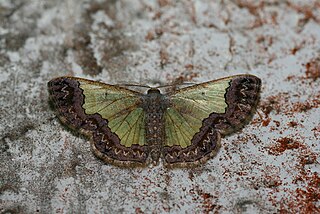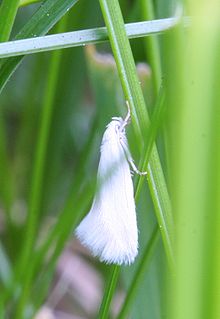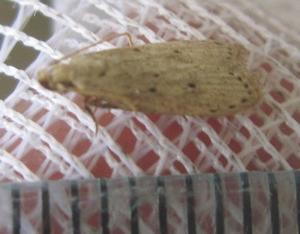Related Research Articles
Ebbe Schmidt Nielsen was a Danish entomologist. Nielsen was influential in systematics and Lepidoptera research, and was an early proponent of biodiversity informatics. The journal Invertebrate Systematics was established with significant contributions from Nielsen and he assisted in the founding of the Global Biodiversity Information Facility (GBIF). Nielsen authored several books, published over eighty scientific papers, and was highly regarded within the scientific community. Following his death, the GBIF organised the Ebbe Nielsen Prize in his memory, awarded annually to promising researchers in the field of biodiversity informatics. The moth Pollanisus nielseni is dedicated to Nielsen.

The Batrachedridae are a small family of tiny moths. These are small, slender moths which rest with their wings wrapped tightly around their bodies.
The inland forest bat is a vespertilionid bat that occurs in central and arid regions in Australia. They were first described in 1987, published in a review of poorly surveyed microbat populations. A tiny flying mammal, whose body is around twelve millimetres (½ inch) long, that occupies small cavities in trees and buildings while roosting. The nocturnal activity is foraging for insects, typically moths.

Glochidion ferdinandi, with common names that include cheese tree, is a species of small to medium–sized trees, constituting part of the plant family Phyllanthaceae. They grow naturally across eastern Australia, from south–eastern New South Wales northwards to northern and inland Queensland, in rainforests and humid eucalypt forests. Frugivorous birds such as pigeons, figbirds and parrots consume its fruit.
Trissobrocha is a monotypic moth genus in the subfamily Arctiinae. Its single species, Trissobrocha eugraphica, is found in Australia, where it has been recorded from New South Wales and Queensland. Both the genus and species were first described by Turner in 1914.
Apoblepta is a monotypic moth genus of moths of the Cybalomiinae subfamily of the Crambidae. It was described by Alfred Jefferis Turner in 1911. It contains only one species, Apoblepta epicharis, which is found in Australia, where it has been recorded from Queensland.
Dolichobela is a monotypic moth genus of the family Crambidae described by Alfred Jefferis Turner in 1932. It contains only one species, Dolichobela celidograpta, described in the same publication, which is found in Australia, where it has been recorded from Queensland.
Macaretaera is a monotypic moth genus of the family Crambidae described by Edward Meyrick in 1886. It contains only one species, Macaretaera hesperis, described by the same author in the same year, which is found in India, Vietnam, Australia (Queensland), Papua New Guinea and on Fiji.
Macrobela is a monotypic moth genus of the family Crambidae described by Alfred Jefferis Turner in 1939. It contains only one species, Macrobela phaeophasma, described by the same author in the same year, which is found in Australia, where it has been recorded from Queensland.

Tetridia is a monotypic moth genus of the family Crambidae described by William Warren in 1890. Its single species, Tetridia caletoralis, was described by Francis Walker in 1859. It is found in China, northern India, Sri Lanka, Myanmar, Malaysia, Papua New Guinea, Japan, Taiwan and Australia, where it has been recorded from Queensland.

Zamarada is a genus of moth in the family Geometridae, first described by Moore in 1887. The species type is Zamarada translucida. Over 250 species and 35 subspecies have been listed.

Sterrhinae is a large subfamily of geometer moths with some 2,800 described species. This subfamily was described by Edward Meyrick in 1892.

The Depressariinae – sometimes spelled "Depressiinae" in error – are a subfamily of moths in the superfamily Gelechioidea. Like their relatives therein, their exact relationships are not yet very well resolved. It has been considered part of family Elachistidae sensu lato or included in an expanded Oecophoridae. In modern classifications they are treated as the distinct gelechioid family Depressariidae.

Elachista is a genus of gelechioid moths described by Georg Friedrich Treitschke in 1833. It is the type genus of the grass-miner moth family (Elachistidae). This family is sometimes circumscribed very loosely, including for example the Agonoxenidae and Ethmiidae which seem to be quite distinct among the Gelechioidea, as well as other lineages which are widely held to be closer to Oecophora than to Elachista and are thus placed in the concealer moth family Oecophoridae here.
Arescoptera is a monotypic snout moth genus described by Alfred Jefferis Turner in 1911. It contains the single species, Arescoptera idiotypa, described in the same article. It is found in Australia, including New South Wales.

Corcyra is a genus of snout moths. It was described by Ragonot in 1885, and is known from China, Great Britain, Australia, and Egypt.

Xyloryctidae is a family of moths contained within the superfamily Gelechioidea described by Edward Meyrick in 1890. Most genera are found in the Indo-Australian region. While many of these moths are tiny, some members of the family grow to a wingspan of up to 66 mm, making them giants among the micromoths.
Marianne Horak is a Swiss-Australian entomologist who specialises in Australian Lepidoptera, particularly the phycitine and tortricid moths. She also did important research on the scribbly gum moths, during which eleven new species of Ogmograptis were discovered.
Brana is a monotypic moth genus of the family Noctuidae. Its only species, Brana calopasa, is found in Sri Lanka and Australia. Both the genus and species were described by Francis Walker, the genus in 1858 and the species in 1859. It It is a serious pest on Berrya cordifolia.
References
- ↑ Savela, Markku. "Aboetheta Turner, 1914". Lepidoptera and Some Other Life Forms. Retrieved 8 March 2018.
- ↑ "Aboetheta pteridonoma". CSIRO Ecosystem Sciences - Australian Moths Online. CSIRO Australia. 3 August 2007. Archived from the original on 5 September 2012. Retrieved 7 April 2011.
- ↑ "Aboetheta Turner, 1914". Butterflies and Moths of the World Generic Names and their Type-species. Natural History Museum, London. Retrieved 8 March 2018.
| This Spilomelinae-related article is a stub. You can help Wikipedia by expanding it. |